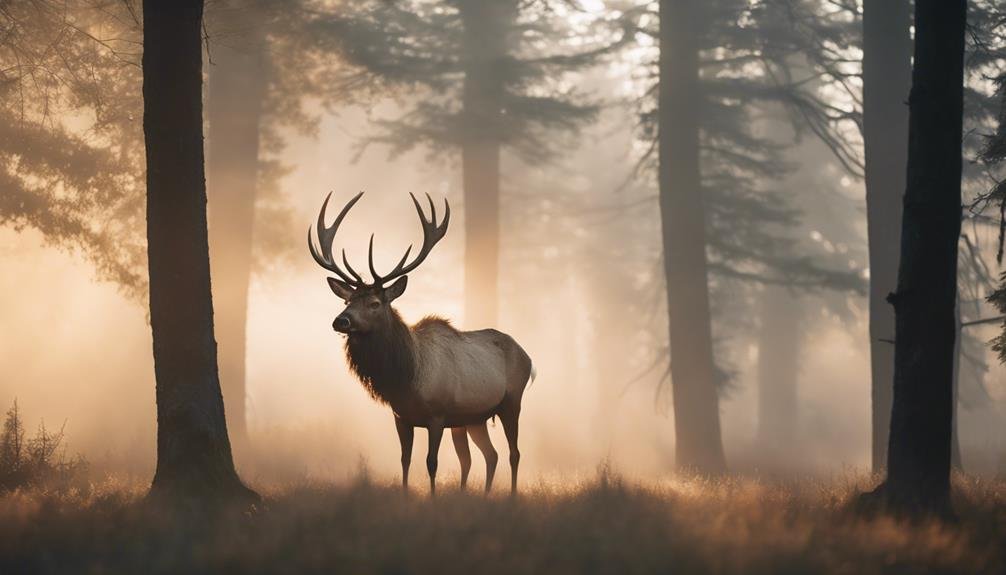You're about to uncover the secrets of elite elk hunters, who have mastered the intricacies of elk behavior, communication, and psychology. To bag a prized bull, you'll need to understand their migration patterns, habitat preferences, and social dynamics. Recognizing and mimicking elk vocalizations is vital, and mastering call sequences and variations is key. As you venture into the world of elk hunting, you'll discover that adaptability, physical conditioning, and private land access are essential. Stay ahead of the competition by learning from the experts, and get ready to reveal the ultimate elk hunting experience.
Key Takeaways
- Mastering elk calling techniques, including bugling, grunting, and chirping, is crucial for connecting with quarry and staying ahead of competition.
- Understanding elk behavior, habitat preferences, and migration patterns helps anticipate their movements and increase chances of success.
- Building relationships with private landowners can grant exclusive access to prime hunting spots, reducing competition and increasing chances of bagging a prized elk.
- Developing physical conditioning through cardio and strength training is essential for tackling steep inclines, long distances, and hauling gear.
- Adapting to varying circumstances, including weather and terrain challenges, is key to success in elk hunting, and having a backup plan is crucial.
Understanding Elk Behavior Patterns
As you venture into elk country, it's essential to grasp the intricacies of their behavior patterns, which can make all the difference between a successful hunt and an exhausting wild goose chase. Elk migration patterns are key to understanding their behavior. During the summer months, elk tend to inhabit high-elevation habitats, seeking refuge in areas with lush vegetation and ample water sources. As winter approaches, they migrate to lower elevations, seeking more abundant food sources and milder climates. Understanding these migration patterns can help you pinpoint potential hotspots and increase your chances of success. Additionally, knowing their habitat selection preferences, such as proximity to water and food sources, can give you an edge in tracking and locating elk.
Vocalization and Communication Strategies
When you're in elk country, being able to decipher the various vocalizations and communication strategies of these majestic creatures can be the difference between a successful hunt and a frustrating experience, and it all starts with understanding the language of elk. Elk are highly vocal, using a range of sounds to communicate, from bugling and grunting to chirps and mews. Don't believe the Hunting Mythbusters who say elk calling is a myth – it's a vital strategy for success. By recognizing and mimicking these vocalizations, you can increase your chances of drawing in elk. Pay attention to the distinct sounds, like elk chirps, and learn to replicate them using game calls. This will help you connect with your quarry and stay one step ahead of the competition.
Effective Hunting Strategies Revealed
With a solid understanding of elk vocalizations and communication strategies under your belt, it's time to develop a hunting strategy that puts you in the best possible position to succeed. Effective hunting strategies involve debunking common hunting myths and understanding elk psychology. By recognizing that elk are social creatures that thrive on interaction, you can use this to your advantage. Here are some key takeaways to inform your strategy:
- Don't believe the myth that elk are solitary animals – they're actually highly social and will often congregate in large groups.
- Understand that elk have a strong sense of hierarchy, with dominant bulls leading the way.
- Elk are highly adaptable, so be prepared to adjust your strategy according to the terrain and weather conditions.
- Use your knowledge of elk psychology to anticipate their movements, increasing your chances of a successful hunt.
Mastering Elk Calling Techniques
You're about to venture on a journey to master the art of elk calling, a skill that requires patience, practice, and a deep understanding of elk vocalizations and behavior. To become a proficient elk caller, crucially, you must grasp the nuances of call sequences and sound variations. Start by learning the different types of elk vocalizations, such as bugles, grunts, and chirps. Practice mimicking these sounds using various call types, like reed-type calls and diaphragm calls. Mastering a range of call sequences, from soft bugles to cow calls, will help you adapt to different hunting scenarios. Remember, the key to success lies in understanding elk behavior and communication patterns. By combining this knowledge with effective calling techniques, you'll increase your chances of attracting elk and making a successful harvest.
Private Land Hunting Advantages
Hunting on private land offers a distinct advantage over public land, as it often means less crowded conditions and a higher likelihood of encountering unpressured elk that are more receptive to calling and other hunting strategies. You'll have a better chance of success when hunting on private land, especially if you've developed strong landowner relationships. This can lead to exclusive property access, reducing competition and increasing your chances of bagging that prized elk.
Here are some benefits of private land hunting:
- Less crowded conditions: You'll have more room to breathe and a better chance of spotting elk without competition.
- Unpressured elk: Elk on private land are often less wary of humans, making them more receptive to calling and other hunting strategies.
- Exclusive property access: Building relationships with landowners can grant you access to prime hunting spots.
- Increased success rates: With fewer hunters and less pressure, you'll have a higher chance of success on private land.
Physical Conditioning Requirements
As you prepare for your elk hunt, remember that your physical conditioning will be put to the test by the rugged terrain and potentially massive elevation changes. You'll need to be in top shape to keep up with these agile creatures. Cardio exercises like running, cycling, or swimming will help you build the endurance needed to tackle steep inclines and long distances. Strength training is also vital, as you'll need to haul your gear and potentially drag an elk carcass out of the wilderness. Focus on exercises that target your legs, core, and upper body to confirm you're well-rounded and prepared. Don't underestimate the physical demands of elk hunting – start training now to avoid fatigue and increase your chances of success.
Essential Gear and Resources
When packing for your elk hunt, prioritize gear that's both functional and durable, like the Argali Outdoors MeatEater x Argali High Country Pack Ultralight Game Bag Set, to guarantee you're prepared for the unpredictable wilderness. You'll need gear that can withstand harsh weather conditions and rugged terrain.
Some essential gear and resources include:
- Garmin inReach Mini 2 for staying connected and tracking your route
- MeatEater Store REVEAL X-Pro Trail Camera for scouting and monitoring elk activity
- Argali Outdoors MeatEater x Argali Large Game M.O.B. Pack Game Bag Set for efficient game transport
- Hunting apps like OnX Maps and BaseMap for navigation and terrain analysis
Elevation and Terrain Challenges
You'll likely face steep elevation gains and losses on your elk hunt, which can be physically draining if you're not adequately prepared. Mountain navigation is essential in elk country, where rugged terrain can quickly turn a hunt into a grueling ordeal. To succeed, you'll need to develop your terrain analysis skills, reading the land to identify hidden water sources, escape routes, and vantage points. This means studying topographic maps, understanding how to use a compass, and developing a keen sense of spatial awareness. By mastering these skills, you'll be better equipped to navigate the challenging terrain and stay one step ahead of your elk. With practice and patience, you'll become a pro at reading the land, and your elk hunting success will soar.
Adapting to Varying Circumstances
In the dynamic world of elk hunting, flexibility is key, and being prepared to adapt to varying circumstances is crucial for success. You never know when the weather will take a turn for the worse or the terrain will throw you a curveball. That's why having a backup plan is crucial, and being prepared for alternative scenarios is paramount for success.
- Weather Contingency: Pack gear that can withstand sudden rain or snow, and know how to navigate in low-visibility conditions.
- Terrain Adaptation: Be prepared to adjust your route or strategy based on the terrain, whether it's steep inclines or dense forests.
- Stay Flexible: Be willing to change your plan if something isn't working, and don't get too attached to a particular strategy.
- Stay Informed: Stay up-to-date on weather forecasts and terrain conditions to make informed decisions in the field.
The Importance of Practice and Study
Your elk hunting skills are only as strong as the time you dedicate to practicing and studying the language of elk. To master the art of elk hunting, you need to commit to regular Elk Calling Drills and immerse yourself in the intricacies of Elk Language Mastery. This means setting aside time to learn and rehearse different calls, from soft bugles to cow calls, until they become second nature. By doing so, you'll develop the confidence and proficiency needed to outsmart and outmaneuver your quarry. Remember, practice doesn't make perfect, perfect practice makes perfect. So, take the time to hone your skills, and you'll be well on your way to becoming a seasoned elk hunter.
Decoding Elk Language and Sounds
As you venture into the fascinating world of elk communication, recognizing that mastering their language and sounds is essential to staying one step ahead of your quarry. Elk whispers, a term used to describe the subtle sounds elk make, can be a game-changer in your hunting strategy. Understanding forest acoustics, how sound travels through the forest, is also pivotal in deciphering elk language.
- Pay attention to the different vocalizations, such as bugles, grunts, and chirps, to identify the elk's mood and intentions.
- Practice recognizing the distinct sounds elk make to locate and track them more effectively.
- Learn to mimic elk sounds using game calls to lure them in or to challenge bulls.
- Study the language of elk to stay one step ahead and increase your chances of a successful hunt.
Frequently Asked Questions
Can Elk Hunting Be Successful During the Moon's Full Phase?
As you plan your hunt, consider the moon's full phase – research suggests elk movement increases during this lunar cycle, so be prepared for more active and vocal elk, increasing your chances of a successful hunt.
How Do Weather Conditions Impact Elk Movement Patterns?
You'll notice elk movement patterns shift with weather conditions; cold fronts can stir them up, while wind directions can dictate their travel routes, so stay alert and adapt your strategy accordingly.
Are There Specific Times of Day for Optimal Elk Hunting?
You think you can just sleep in and still bag that elk? Think again! Prime elk hunting happens during Early Light, when they're most active, and Late Bed, when they're least expecting it – don't get caught snoozing!
Can Elk Be Successfully Hunted on Public Land With High Pressure?
You can successfully hunt elk on public land with high pressure by adapting to access restrictions and hunter density, using strategies like early morning or late evening hunts, and being prepared to hike further to find less-pressured areas.
Are There Specific Elk Hunting Strategies for Early Season Archery?
You'll be amazed that elk can lose 20% of their body weight during the rut! For early season archery, focus on early scouting to identify patterns and pre-season prep to perfect your calling strategies, ensuring a successful hunt.
Conclusion
As you stand at the threshold of your elk hunting journey, the wilderness beckons like an untamed beast, waiting to be conquered. With the secrets of elk behavior, vocalization, and hunting strategies now in your arsenal, you're ready to venture on a thrilling adventure. The wind whispers secrets in your ear, and the trees lean in, anxious to share their ancient wisdom. The hunt is on – are you ready to release your inner predator and claim your rightful place among the elite ranks of elk hunters?









